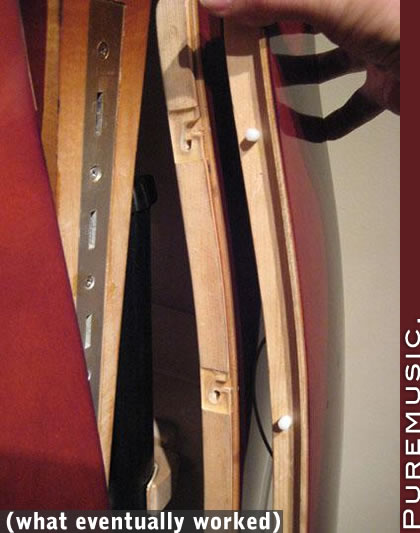
A Conversation with Charlie Chadwick (continued)
CC: But the problem that I was having was that you open a back up, once you've cut the back, it'll never just return to the same shape. You have to measure the shape of the inside of the bass before you cut it. And that's a big problem, because the only way to look inside the bass is through these little F-holes, and you certainly can't put any tools down there. You can shine a flashlight and look at it, but how are you going to measure the exact curve of the bass from the outside?
It's not an easy problem to solve, to build a brace from the outside, a locking brace that fits perfectly. And my first attempt at it, it worked, but not so pretty, not too great. I wrestled with that for a while. I'm telling you, this process was a three-year process.
PM: Wow.
CC: Okay, fast forward to 2007. I'd bought a bass from a company, Sam Shen, and he is one of the premier Chinese manufacturers of basses.
PM: How do you spell his last name?
CC: S-h-e-n. And Shen instruments are sold all over the world. And it's a very nice bass. I went on the internet and researched upright basses. I wanted to find a bass to put all of my modifications on, a nice finished bass, because everything I was chopping up was all old stuff and pieces of junk. I didn't want to ruin a good instrument. But I finally had the design working, and I wanted to put all of these features onto a finished prototype that actually looked good and worked perfectly. So I looked around, and the Shen -- his top of the line plywood bass was the one that I latched onto. When I found that one, I thought, "This is a great instrument. I'll modify one of these Sam Shen basses." It looked great and well built. So I bought one, took this brand new bass and went out in the garage and I cut it all to pieces.
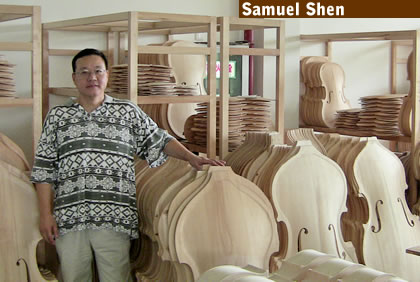
And I modified it. And that's the one that I recorded and listened to the changes in from beginning to end. And it worked great, and it was a hit. It just worked perfect. I started taking it to gigs.
About three months later I had a gig at the summer NAMM Show. John Jorgenson was playing the NAMM party for Rick Shubb at Saga Musical Instruments.
PM: Very cool.
CC: Yeah, so we're playing at a party. And the fellow that I had bought the Sam Shen bass from, Paul Strelau, he's located in New York. And his company, CSC Products, is the North American distributor for Shen Musical Instruments. So I bought the instrument from CSC. And I was in conversation with the CSC people, and Paul said, "Well, Sam Shen is going to be at the NAMM Show, would you like to meet him?" "Yeah!" I said. But I'm a little concerned -- is he going to be upset that I cut his bass all up? I mean, this could be disturbing. But Paul said, "Oh, no, Sam loves this kind of thing. He'd get a kick out of it." I had told CSC what I was doing with their instrument.
And so we meet. Sam came to the party and we met afterwards. And he was a wonderful gracious guy. He was not at all what I'd expected. He'd lived maybe 20 years in Canada -- he'd left China when communism pretty much shut down entrepreneurship and all that. He'd moved to Canada and was building instruments up there and developing --
PM: Where?
CC: Where in Canada? I'd have to research it.
Sam had developed the contacts with Canadian wood, and he became a builder in Canada.
PM: How interesting.
CC: Yeah. But when things started to open up in the late '80s, early '90s, he saw an opportunity. He's a Chinese citizen, he speaks fluent Chinese, he understands Chinese mentality, and he knew there was an opportunity to make instruments in China. And he went to China as a Canadian, and opened up his factory in China and began making musical instruments. Well, so he's at the NAMM Show. He's doing very well, his company has been highly successful.
PM: What's their big product, string instruments?
CC: All orchestra instruments in the violin family. Saga will get into dobros and mandolins and all that.
PM: They have electric guitars out the wazoo.
CC: Yeah, exactly, and gypsy guitars and all that stuff. And that's our connection with Saga, they were making a gypsy guitar for John Jorgenson.
So Sam and I meet at the NAMM Show. I'm standing there, I'm holding my bass. He came up after the show and said, "I really would like to see the bass." And I said, "You're looking at it."
PM: Wow.
CC: Yeah, the guy who made it, he goes, "What?" I said, "Check this out." I turn the bass around, I pull the back door up, and it releases into my hand, and Sam gets it right away. He just understands all of it. He says, "Oh, okay, uh-huh." He's looking at this thing. He's saying, "This is brilliant. It's brilliant. I love this. It's so good." And I'm thinking, "Oh, good, he's not going to --"
PM: What a moment!
CC: It was a moment. And he said, "There's a fellow in France who has a type of neck removal system, but this is much, much better." He knew what was going on in this field.
PM: And had you heard of this French guy yet?
CC: No. I didn't know who this was. Then Sam says to me, "If I was to do this, this piece here that you made with plastic, I would make with ebony, that's better. And this finish, it's not so good. You should finish this part also." He's actually seeing -- he understood it completely in seconds. And I said, "Well, Sam, everything you're looking at here came from Home Depot."
[laughter]
CC: "I don't have access to the materials."
PM: "I don't have a factory."
CC: Yeah. I had to cut a finished bass, trying not to mar the finish in any way, because I can't reproduce the finish.
PM: Of course not.
CC: He said, "I could do this much better." I said, "I would love for you to do this! I would love for you to make these for me, because this one took me a couple of weeks to do in my own laboring way. And there's obviously no profit in making those."
PM: Right.
CC: "And it's a pain in the ass, and I want to go work in my studio and play my bass, and I don't want to be making basses." So that conversation began. He said, "You should come to China, and we'll talk." And I thought, well, that's great. I was very excited. But a couple of months went by, and I thought, well, that might have been a very polite way of saying, "Yeah, it's cute, a nice idea but..."
That was in January. In April I got a call from my contact at CSC, who said, "Sam wants to know if you want to come. Can you come?" I said, "Yeah, let's go." He said, "I'm coming out in about a month, if you want to join me, we'll go together." So I went out there for a week, and we talked design, and I left Sam pictures and drawings. And I found him to be just so enthusiastic and cooperative and excited about doing it. Never and to this moment no contracts or any formal agreements have been drafted or signed, we're just a couple of guys trying to make this happen.
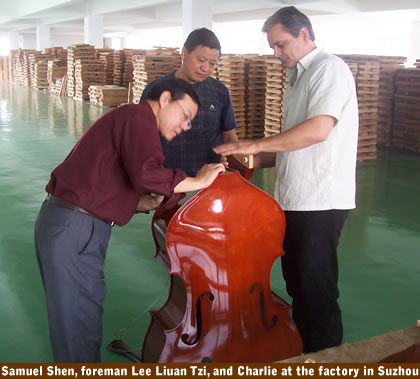
PM: Wow. How old is Sam Shen?
CC: It's hard to tell. I would say early 40s, that would be my guess.
PM: Oh, that's all.
CC: Yeah, yeah. And he's just a marvelous happy guy. We went out and had dinner every night after working. At about 5:00, 6:00, we'd go have a Chinese beer and some exotic food, fried jellyfish or duck tongue or something exotic. And he's just a gracious wonderful guy and not at all uptight or stressed in any way.
PM: Is he closer to Shanghai?
CC: Yeah, more to Shanghai. He's just about 40 kilometers west of Shanghai.
PM: Did you get to hang in the city at all in Shanghai?
CC: Yeah, a little bit. He has a violin shop in Shanghai, a very elegant place. And now he has a shop in Beijing also.
PM: Shanghai is amazing.
CC: Oh, yeah, great town. And of course, I probably didn't see much of it. But we hung out in Suzhou, and that's where his main factory is. He also has a factory in the north for plywood instruments.

So that trip went very well. He ended up making a bass in the next couple of months and sending it to me. And we went over the design, changed a few things.
As fate would have it, John Jorgenson had a trip to Shanghai for a trade show, so we coordinated with Sam, and I went and visited with him for another week, in 2008. We had a couple of weeks together in Shanghai refining the bass, and then started working on the case details.
Like I said, the case has been the biggest pain in the ass. It's unbelievable that it would be such a difficult proposition. But if you think about it, here's the problem: the bass, with strings, soaking wet, weighs about 27 pounds. Well, the case can't weigh more than 22 pounds if you want to keep it under 50. That's the problem. That's a huge problem. I mean, 22 pounds?
PM: That's not much, not for a case.
CC: No. And the case has to be absolutely as small as possible.
PM: Sure.
CC: Okay. But the smaller it is, the less padding, the less reinforcement. So what material do you make it out of? How do you reinforce it so that the thing can be dropped from, say, two feet drop, just drop it from two feet in the air onto the hard concrete, and not have the case or the bass destroyed? And the case has to be light weight, too. So it's not such a simple thing.
I was trying to make the case and bass under 50 pounds so it meets the airline standard for luggage, and as small as physically possible so it doesn't look like you're shipping some giant box. So the design that I came up with actually follows the contour of the bass. It's got a curved back and top, arch top, and it's in the shape of the bass except that it doesn't have the cutouts in the middle, so it's kind of pear shaped, smaller at the top, flat at the bottom. And it's a hard shell case. We made the case out of another bass top and another bass back. So it's a bass in a bass, if you can picture that. That's what the case is.
PM: Wow.
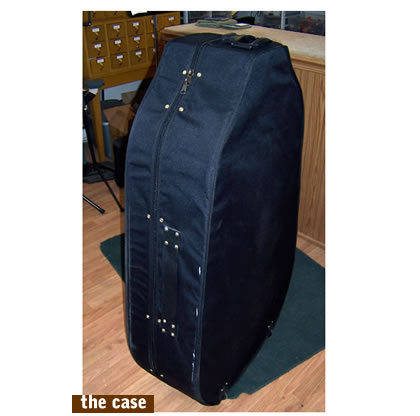
CC: We spent some time designing it. Sam made five cases and threw them all out because they weren't exactly the right dimension, internal dimension. Because we're cutting it as close as possible. So the sixth case worked, he sent it to me, and I redesigned the lining. I wasn't happy with the lining, but the case was brilliant, it was perfect. So that's where we're at right now: we've finally got the case. Finally. The last bugger in this whole thing was the case. Believe it or not, the hardest part.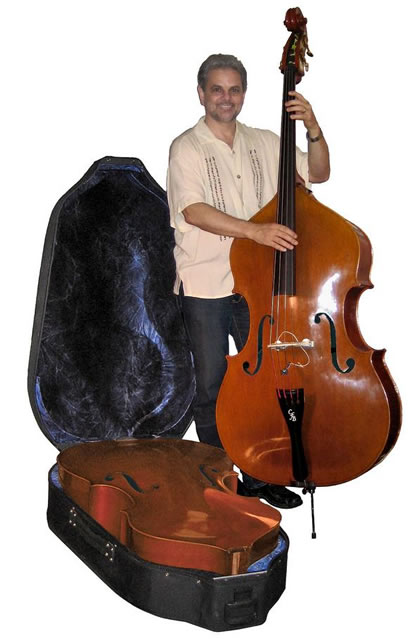
And the case and bass now are under 50 pounds. They can resist normal and somewhat worse than normal handling without the bass being damaged. The sound post doesn't fall over, the things don't get tangled. And the bass sets up -- I've never tried to do it as fast as I can do it, but I set it up in under 2 minutes. From the case to tuned, ready to play, under two minutes. I can take it apart in even less time. [You really should watch Charlie doing this! See it here] Normal for me is about a minute and 15 seconds to minute and a half -- completely disassembled, packed, ready to put in the airplane. You don't have to do any strapping or special pieces of foam. You just collapse it, put it in the box, zip the box shut, and take it to the airline. It's ready to go. And when I was able to have the design work that well, that was when I knew this would be really useful to other bass players.
PM: Right.
CC: If you have to build a bass in order to use it, or know about setups, then it's too complicated and nobody is going to really want it. I used to take this thing to trade shows for years showing people -- I didn't care, steal the idea if you want, because it's not commercial. But when I got the neck to fold, the back to lock --
PM: You stopped taking it around then.
CC: Uh-uh. "You're not looking at this one until I get it patented." So in April of '07, I went to a patent attorney in Nashville, Waddey & Patterson is the firm. And we began the patent process. And we filed our patent in October of '07. I knew this was a good idea. The idea was never intended to be a business proposition. I had never intended to make a bass or to make it available. I just wanted to not play a piece of shit bass on my gigs. I wanted to travel with my own bass to my gigs. And eventually it became evident that my solution was a very, very good idea.
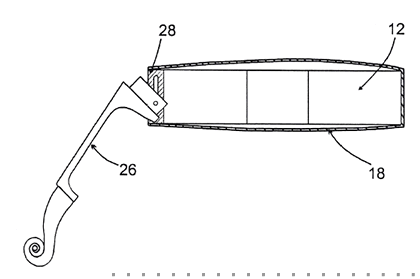
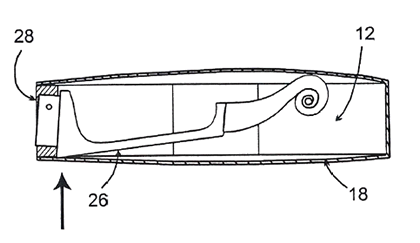
When I came up with the folding neck, in late '06, early '07, you wouldn't believe the crowds that would gather. People love to see that thing fold up. They weren't that interested in a removable neck. That didn't excite people. But they love seeing it fold.
PM: "Watch the man saw the bass in half!"
[laughter]
CC: People flipped out, seriously. I've been playing shows with John Jorgenson, and the audience is half guitar players, as you can imagine, if they all dragged along any of their girlfriends with them. And after the show, the guitar players gather and want to look at John's gear and talk to him. Well, I was gathering a bigger crowd taking my bass apart on stage.
PM: [laughs]
CC: It was unbelievable, and I knew this was hot. And I asked myself a simple question: Do I want to open a musical instrument catalog another year or two from now and see my design and have somebody else making it? It would be whacked. And I said to myself, this really doesn't make any sense. I've spent a lot of time on this, and I've got a solution that I know works. It solved my travel problems. Solved. And I've had so many bass players say, "Oh, my God, could you modify my bass? Could you make one of these for me?" And the answer is no, no way.
PM: "Absolutely not, not unless I'm going to make a thousand of them."
CC: Yeah. So my idea was I wanted to exploit it from my point of view to get the benefit for my hard work on this.
PM: So you get paid, essentially.
CC: Yes, but not have to make them myself. And my relationship with Sam Shen made that all possible. And the patent was there so that we don't have any unfair competition. Because the idea, as all effective ideas are, is bonehead simple when you see how I did it.
PM: Amazing.
CC: It's not complicated.
PM: But to arrive at that bone-headedly simple conclusion took quite a long time and a lot of brain power and trial and error. And it's amazing what simple solutions take to arrive at.
print (pdf) listen to clips puremusic home

